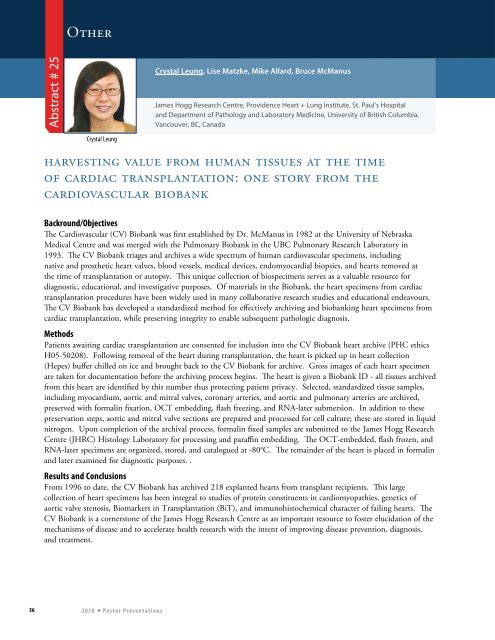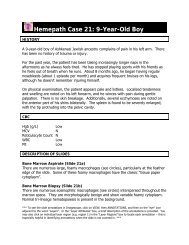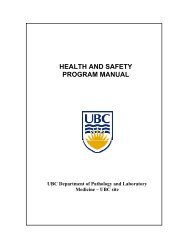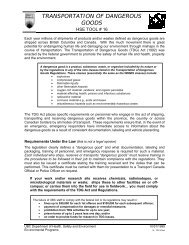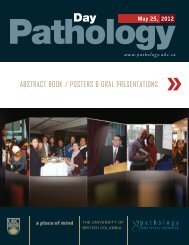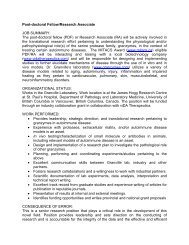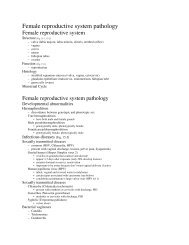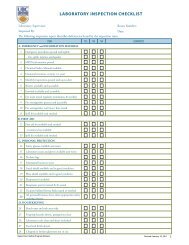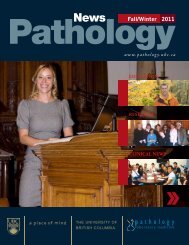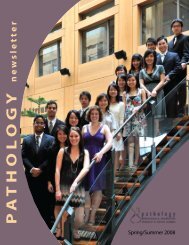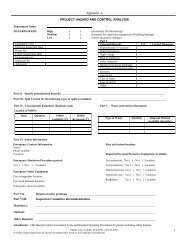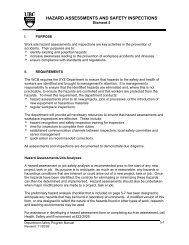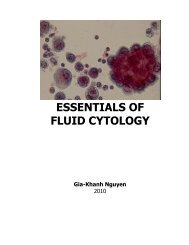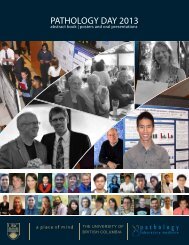Oral Presentations - Pathology and Laboratory Medicine - University ...
Oral Presentations - Pathology and Laboratory Medicine - University ...
Oral Presentations - Pathology and Laboratory Medicine - University ...
You also want an ePaper? Increase the reach of your titles
YUMPU automatically turns print PDFs into web optimized ePapers that Google loves.
OtherAbstract # 25Crystal Leung, Lise Matzke, Mike Allard, Bruce McManusJames Hogg Research Centre, Providence Heart + Lung Institute, St. Paul’s Hospital<strong>and</strong> Department of <strong>Pathology</strong> <strong>and</strong> <strong>Laboratory</strong> <strong>Medicine</strong>, <strong>University</strong> of British Columbia,Vancouver, BC, CanadaCrystal Leungharvesting value from human tissues at the timeof cardiac transplantation: one story from thecardiovascular biobankBackround/ObjectivesThe Cardiovascular (CV) Biobank was first established by Dr. McManus in 1982 at the <strong>University</strong> of NebraskaMedical Centre <strong>and</strong> was merged with the Pulmonary Biobank in the UBC Pulmonary Research <strong>Laboratory</strong> in1993. The CV Biobank triages <strong>and</strong> archives a wide spectrum of human cardiovascular specimens, includingnative <strong>and</strong> prosthetic heart valves, blood vessels, medical devices, endomyocardial biopsies, <strong>and</strong> hearts removed atthe time of transplantation or autopsy. This unique collection of biospecimens serves as a valuable resource fordiagnostic, educational, <strong>and</strong> investigative purposes. Of materials in the Biobank, the heart specimens from cardiactransplantation procedures have been widely used in many collaborative research studies <strong>and</strong> educational endeavours.The CV Biobank has developed a st<strong>and</strong>ardized method for effectively archiving <strong>and</strong> biobanking heart specimens fromcardiac transplantation, while preserving integrity to enable subsequent pathologic diagnosis.MethodsPatients awaiting cardiac transplantation are consented for inclusion into the CV Biobank heart archive (PHC ethicsH05-50208). Following removal of the heart during transplantation, the heart is picked up in heart collection(Hepes) buffer chilled on ice <strong>and</strong> brought back to the CV Biobank for archive. Gross images of each heart specimenare taken for documentation before the archiving process begins. The heart is given a Biobank ID - all tissues archivedfrom this heart are identified by this number thus protecting patient privacy. Selected, st<strong>and</strong>ardized tissue samples,including myocardium, aortic <strong>and</strong> mitral valves, coronary arteries, <strong>and</strong> aortic <strong>and</strong> pulmonary arteries are archived,preserved with formalin fixation, OCT embedding, flash freezing, <strong>and</strong> RNA-later submersion. In addition to thesepreservation steps, aortic <strong>and</strong> mitral valve sections are prepared <strong>and</strong> processed for cell culture; these are stored in liquidnitrogen. Upon completion of the archival process, formalin fixed samples are submitted to the James Hogg ResearchCentre (JHRC) Histology <strong>Laboratory</strong> for processing <strong>and</strong> paraffin embedding. The OCT-embedded, flash frozen, <strong>and</strong>RNA-later specimens are organized, stored, <strong>and</strong> catalogued at -80°C. The remainder of the heart is placed in formalin<strong>and</strong> later examined for diagnostic purposes. .Results <strong>and</strong> ConclusionsFrom 1996 to date, the CV Biobank has archived 218 explanted hearts from transplant recipients. This largecollection of heart specimens has been integral to studies of protein constituents in cardiomyopathies, genetics ofaortic valve stenosis, Biomarkers in Transplantation (BiT), <strong>and</strong> immunohistochemical character of failing hearts. TheCV Biobank is a cornerstone of the James Hogg Research Centre as an important resource to foster elucidation of themechanisms of disease <strong>and</strong> to accelerate health research with the intent of improving disease prevention, diagnosis,<strong>and</strong> treatment.36 2 0 1 0 * P o s t e r P r e s e n t a t i o n s


